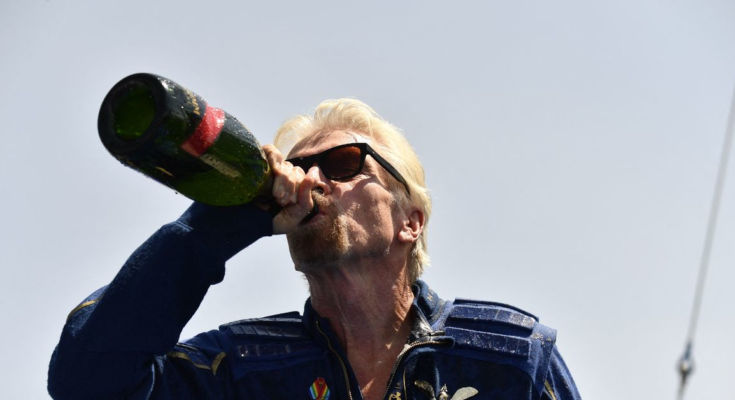Richard Branson’s extravagant jaunt to space on Sunday signaled the dawning of a new space age — for the few people that can afford it. Jeff Bezos is about to set off on a similar excursion next Tuesday when he launches to space with three others on his company Blue Origin’s first crewed flight. The two billionaires are validating their companies’ tourist-tailored rockets and, they say, fulfilling lifelong dreams to get a brief taste of space.
But what Virgin Galactic’s mission on Sunday proved, and what Bezos’ flight will similarly show, is that space is almost open, not for you and me or the general public, but for more billionaires.
Opening up the cosmos to the masses and normalizing space travel is a goal companies and their billionaire backers have been targeting for years but haven’t yet achieved. There’s economic potential beyond launching rich people to space: microgravity research for scientists and — a much farther goal — rapid transportation between continents. That’s the vision they’re selling with these flashy flights; once exclusive to government astronauts, traveling in space could be a thing for everyone else too.
“That’s the dream, right? That space isn’t just for NASA anymore,” Kathy Lueders, NASA’s human spaceflight chief who oversaw development of SpaceX’s Crew Dragon astronaut capsule, said during a press conference in April. “I mean, I think that’s what we’re trying to do… what we were hoping is that you would hopefully have so many customers that at one point, the price-point would go down to having it be accessible. It’s tough at the beginning.”
In this beginning phase, flying to space is priced only for the ultra-rich, driven by the high costs of new space technology. Virgin Galactic’s launch of Richard Branson represented one of the final key test missions to validate its shiny six-seated spaceplane, SpaceShipTwo, but it was also a meticulously crafted marketing event, complete with flashy promo videos, inspirational speeches, and a pop concert, all designed to help attract more attention, and more customers.
:no_upscale()/cdn.vox-cdn.com/uploads/chorus_asset/file/22723074/1233922260.jpg)
To live their own version of Branson’s dream, customers will have to pay at least $250,000 for a seat (the company already has roughly 600 booked passengers). And right now, the quarter-million-dollar price tag is the cheapest option on the market. The price for a seat on Blue Origin’s New Shepard rocket could be higher. And if you want to go into orbit for a few days, a ride on SpaceX’s Crew Dragon capsule will set you back at least $55 million (that could be higher too; SpaceX hasn’t publicly confirmed the real price).
While Branson and Bezos’ flights to space mark key moments for their space tourism businesses, the space industry is far from being able to offer its services to the rest of the public. To get there, they’ll have to clear several hurdles: Can these rockets reliably fly humans on multiple missions without a hitch? If there is a hitch, like a fatal accident, can the market survive a damaged reputation? And can someone buy a ticket to space just as they can book an expensive flight (instead of just the ultra-rich)?
Then there’s the court of public opinion, which may be difficult to win over. Bezos, Branson and Elon Musk’s space ambitions have been criticized as another example of billionaires spending money on passion projects when there are places and causes where those funds could arguably be put to better use. The US alone struggles with vast wealth inequities, poor access to healthcare and a rapidly changing climate, among other problems that, when paired with space tourism, makes the activity look insultingly selfish to many. Sen. Bernie Sanders (I-VT), a leading critic of billionaires, has repeated that point as the private space race heats up. “Here on Earth, in the richest country on the planet, half our people live paycheck to paycheck, people are struggling to feed themselves, struggling to see a doctor — but hey, the richest guys in the world are off in outer space!,” he tweeted in March.
Here on Earth, in the richest country on the planet, half our people live paycheck to paycheck, people are struggling to feed themselves, struggling to see a doctor — but hey, the richest guys in the world are off in outer space!
Yes. It’s time to tax the billionaires.
— Bernie Sanders (@BernieSanders) July 11, 2021
“I can understand it,” Branson says of critiques like Sen. Sanders’, speaking on The Late Show with Stephen Colbert on July 14th. “But I think maybe they’re not fully educated as to what space does for Earth.” Branson, like other space advocates, point to the technologies that investments in space have helped propel into the mainstream, like the GPS capabilities wired into smartphones, weather tracking services or climate change research and modeling from satellites in low-Earth orbit. Many of those investments came from public funds — it’s still unclear what spin-off developments might emerge from the still-fledgling private space tourism industry.
As long as the space industry is dependent on billionaire funds for spacecraft built for billionaire (and millionaire) customers, the perception that this is a hobby for the ultrawealthy will inevitably remain. “We have to deal with the fact that billionaires trying to make more money are the public face of the space sector right now,” Brian Weeden, a director at the Secure World Foundation, said.
:no_upscale()/cdn.vox-cdn.com/uploads/chorus_asset/file/22723050/1236085488.jpg)
Putting faces on nascent industries isn’t unusual in itself. Charles Lindbergh, the first pilot to fly across the Atlantic Ocean alone, famously helped propel commercial aviation from its infancy in the 1920s and 1930s. Same with Steve Jobs or Bill Gates at the dawn of the desktop computer at the end of the 20th century.
Those industries, too, had doubters and critics. The US was skeptical of the early planes being built by the Wright brothers and top military officials dismissed aviation as a fad. “Any man who sticks to it is either crazy or else a plain damned fool,” said American Admiral William A. Moffett, who would later embrace aviation under the Navy’s Bureau of Aeronautics. And in 1943, when computers were massive room-sized objects, the chairman of IBM, Thomas Watson, scoffed at their potential: “I think there is a world market for maybe five computers.”
Flights became commonplace. Computers became less expensive and more widely used. And at each phase of the computer’s evolution, people found new ways to use them as they became accessible to more markets and a wider swath of consumers, notes Carissa Christensen, CEO of BryceTech, a tech and space industry analytics firm.
:no_upscale()/cdn.vox-cdn.com/uploads/chorus_asset/file/22477954/665033922.jpg)
“There’s going to be a fairly large learning curve as companies go from the process of developing a capability and testing it, to operating it routinely,” Christensen said. It’s possible that space tourism will follow the same path as computers or airplanes, but there’s no guarantee that it will succeed. In part, that’s because there’s no single solution to driving down the cost of launching people to space. Virgin Galactic earlier this year unveiled a new version of SpaceShipTwo that’s tailored for quick production rates, signaling it’s gearing up to accommodate its hefty customer backlog and reopen ticket sales, which have been closed since a fatal 2014 accident during a test flight. (Branson’s presence on Sunday’s flight also served as a visual reassurance to customers that the ship is safe.) Musk is focusing on better rocket fuel efficiency with SpaceX’s Starship, a fully reusable launch system being developed to slash the cost of sending humans to space.
But again, what exactly those next-generation prices will be remain a mystery. Musk hasn’t said how much it’ll cost prospective passengers to fly on Starship. And Virgin Galactic hasn’t said how much it plans to charge for tickets for its newer spaceplane, SpaceShipThree, just like Blue Origin, which hasn’t revealed its New Shepard prices.
Currently, you either have to be talented (hand-picked by a billionaire) or lucky to book a ride on one of these rockets without paying the steep price tag. Raffling off tickets, like Virgin Galactic plans to do, and donating seats to space enthusiasts who can’t afford them keeps the public dream of normalized, low-cost space travel alive while the industry races to find the right recipe for bringing prices down. “I think that in any competitive market you’re going to see products improve and/or prices drop,” Christensen added.
The competition has only just begun, and other companies are angling to get into space tourism. Texas-based Axiom Space has plans to build a private space station and arrange private rides on SpaceX’s Crew Dragon capsules. A new rocket under development by Rocket Lab, the California-based launch company that plans to go public, is designed to launch humans to space in the future. Boeing’s Starliner capsule is designed to ferry private astronauts to the space station, too.
At the moment, there’s no telling which one will make it — if any of them do. For now, space tourism is still in a phase controlled by billionaire cash. Whether or not the industry can grow out of the spectacle and into something more mature will depend less on Bezos or Branson fulfilling their childhood dreams of flying to space and more on bringing down the cost of building rockets — and the price we pay to fly on them.



